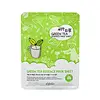What's inside
What's inside
 Key Ingredients
Key Ingredients

 Benefits
Benefits

 Concerns
Concerns

No concerns
 Ingredients Side-by-side
Ingredients Side-by-side

Galactomyces Ferment Filtrate
HumectantAspergillus Ferment Extract Filtrate
HumectantSaccharomyces Ferment Filtrate
HumectantPropanediol
SolventNiacinamide
SmoothingButylene Glycol
Humectant1,2-Hexanediol
Skin ConditioningAloe Barbadensis Leaf Extract
EmollientEllagic Acid
Skin ConditioningAronia Melanocarpa Fruit Extract
Skin ConditioningPolyglutamic Acid
Skin ConditioningGlycerin
HumectantCorallina Officinalis Extract
Skin ConditioningSodium Hyaluronate
HumectantMorus Alba Root Extract
BleachingAllantoin
Skin ConditioningOcimum Sanctum Leaf Extract
Skin ConditioningRibes Nigrum Fruit Extract
AstringentRubus Coreanus Fruit Extract
Skin ConditioningLycium Chinense Fruit Extract
AntioxidantCurcuma Longa Root Extract
MaskingGlycyrrhiza Uralensis Root Extract
Skin ConditioningRubus Fruticosus Fruit Extract
AstringentRubus Idaeus Fruit Extract
AstringentBetaine
HumectantVaccinium Myrtillus Fruit Extract
Skin ConditioningAristotelia Chilensis Fruit Extract
Skin ConditioningEuterpe Oleracea Fruit Extract
Vaccinium Angustifolium Fruit Extract
Skin ProtectingAloe Barbadensis Flower Extract
EmollientSolanum Melongena Fruit Extract
Skin ConditioningGardenia Jasminoides Fruit Extract
Cosmetic ColorantSodium Polyacryloyldimethyl Taurate
Emulsion StabilisingEthylhexylglycerin
Skin ConditioningMelia Azadirachta Leaf Extract
Skin ConditioningMelia Azadirachta Flower Extract
Skin ConditioningXanthan Gum
EmulsifyingCoccinia Indica Fruit Extract
Skin ConditioningPortulaca Oleracea Extract
Skin ConditioningWater
Skin ConditioningMethylpropanediol
SolventGalactomyces Ferment Filtrate, Aspergillus Ferment Extract Filtrate, Saccharomyces Ferment Filtrate, Propanediol, Niacinamide, Butylene Glycol, 1,2-Hexanediol, Aloe Barbadensis Leaf Extract, Ellagic Acid, Aronia Melanocarpa Fruit Extract, Polyglutamic Acid, Glycerin, Corallina Officinalis Extract, Sodium Hyaluronate, Morus Alba Root Extract, Allantoin, Ocimum Sanctum Leaf Extract, Ribes Nigrum Fruit Extract, Rubus Coreanus Fruit Extract, Lycium Chinense Fruit Extract, Curcuma Longa Root Extract, Glycyrrhiza Uralensis Root Extract, Rubus Fruticosus Fruit Extract, Rubus Idaeus Fruit Extract, Betaine, Vaccinium Myrtillus Fruit Extract, Aristotelia Chilensis Fruit Extract, Euterpe Oleracea Fruit Extract, Vaccinium Angustifolium Fruit Extract, Aloe Barbadensis Flower Extract, Solanum Melongena Fruit Extract, Gardenia Jasminoides Fruit Extract, Sodium Polyacryloyldimethyl Taurate, Ethylhexylglycerin, Melia Azadirachta Leaf Extract, Melia Azadirachta Flower Extract, Xanthan Gum, Coccinia Indica Fruit Extract, Portulaca Oleracea Extract, Water, Methylpropanediol
 Reviews
Reviews

Ingredients Explained
These ingredients are found in both products.
Ingredients higher up in an ingredient list are typically present in a larger amount.
Betaine is a common humectant (a substance that promotes retention of moisture). It's known to be gentle on the skin and can help balance hydration.
This ingredient is best for improving hydration and soothing irritated skin. Studies also show it helps even out skin tone.
Fun fact: Betaine is naturally created in the skin and body. The kind found within cosmetic products can be either plant-derived or synthetic.
Another name for betaine is trimethylglycine.
Learn more about BetaineGlycerin is already naturally found in your skin. It helps moisturize and protect your skin.
A study from 2016 found glycerin to be more effective as a humectant than AHAs and hyaluronic acid.
As a humectant, it helps the skin stay hydrated by pulling moisture to your skin. The low molecular weight of glycerin allows it to pull moisture into the deeper layers of your skin.
Hydrated skin improves your skin barrier; Your skin barrier helps protect against irritants and bacteria.
Glycerin has also been found to have antimicrobial and antiviral properties. Due to these properties, glycerin is often used in wound and burn treatments.
In cosmetics, glycerin is usually derived from plants such as soybean or palm. However, it can also be sourced from animals, such as tallow or animal fat.
This ingredient is organic, colorless, odorless, and non-toxic.
Glycerin is the name for this ingredient in American English. British English uses Glycerol/Glycerine.
Learn more about GlycerinThis extract comes from Purslane, a succulent. It has anti-inflammatory, antioxidant, and hydrating properties.
Purslane is very nutritious. It contains omega-3 fatty acids, NMFs, many vitamins, minerals, and antioxidants. The vitamins found in purslane include: Vitamin C, Vitamin A, and Vitamin E.
Fun fact: Purslane is a succulent with an extensive habitat. It is used in traditional Korean medicine to treat irritated skin.
Nowadays, purslane is becoming a superfood due to its highly nutritious content.
Learn more about Portulaca Oleracea ExtractSodium Hyaluronate is hyaluronic acid's salt form. It is commonly derived from the sodium salt of hyaluronic acid.
Like hyaluronic acid, it is great at holding water and acts as a humectant. This makes it a great skin hydrating ingredient.
Sodium Hyaluronate is naturally occurring in our bodies and is mostly found in eye fluid and joints.
These are some other common types of Hyaluronic Acid:
Learn more about Sodium HyaluronateWater. It's the most common cosmetic ingredient of all. You'll usually see it at the top of ingredient lists, meaning that it makes up the largest part of the product.
So why is it so popular? Water most often acts as a solvent - this means that it helps dissolve other ingredients into the formulation.
You'll also recognize water as that liquid we all need to stay alive. If you see this, drink a glass of water. Stay hydrated!
Learn more about Water